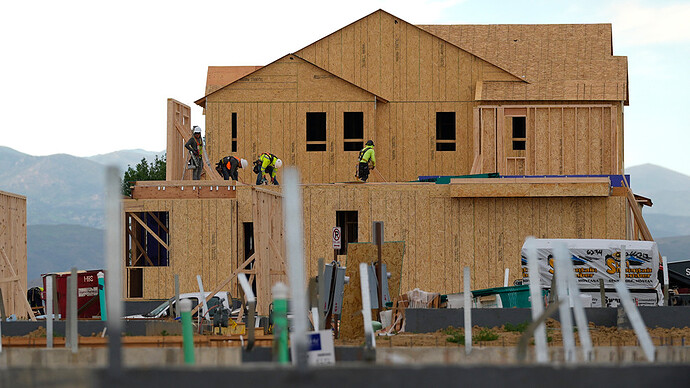WASHINGTON (TNND) – A housing market that has been stuck at multidecade lows in activity over the last two years is facing yet another obstacle as escalating trade wars and uncertainty over how trade policy from the White House will impact the economy have created fears of a recession.
The main obstacle facing the market over the last two years has been affordability with prices staying high after skyrocketing during the pandemic-era housing market boom and mortgage rates that climbed to 7% and added hundreds of dollars onto a monthly mortgage payment.
Mortgage rates usually fall during times of economic uncertainty but have shown little signs of moving this year despite a chaotic two-week stretch on Wall Street and increasing pessimism about the direction of the economy from investors and consumers.
The average rate on a 30-year mortgage dropped modestly to 6.62% this week, compared to 6.64% a week earlier, mortgage buyer Freddie Mac said Thursday. Most analysts are not expecting rates to move meaningfully this year with uncertainty being the driving force in the bond market and keeping them elevated.
“Despite recent swings, our long-term view has not changed significantly. Rates are likely to remain volatile through the spring and early summer, but unless inflation picks up meaningfully, the broader trend should still be modestly downward,” said Emanuel Santa-Donato, SVP and chief market analyst at Tomo Mortgage. “Unusually, Treasuries and the U.S. dollar are not behaving like traditional safe havens. In typical periods of volatility, investors would flock to Treasuries and the dollar, pushing mortgage rates lower and stabilizing the currency. This time, both assets have been unusually unstable, reflecting deeper concerns about inflation and the long-term impacts of trade disruptions.”
Modest improvements in mortgage rates have spurred some recent boosts for the slumping markets with more applications for mortgages. The Mortgage Bankers Association reported this week that purchase applications increased by 20% for the week ending April 4, the highest level since 2024.
But that momentum is unlikely to continue moving forward as market volatility causes fluctuations in the 10-year Treasury bonds that mortgage rates tend to follow, and economic uncertainty takes root for buyers who may be hesitant to make a significant financial move with fears of a recession.
President Donald Trump’s reciprocal tariffs that have since been put on a 90-day pause have roiled Wall Street and prompted economists to increase the odds of a recession, further stirring uncertainty facing the housing market.
Part of economists’ concerns about slower economic growth is consumers pulling back on spending due to fears of a recession. Consumers tend to pull back on making big purchases like homes and cars when faced with the prospect of shaky job security or a worsening economy.
Americans’ attitudes about the economy have been in a tailspin over the last several months as they become increasingly anxious about the impact tariffs will have on its strength and inflation. A preliminary reading from the University of Michigan’s consumer sentiment index released Friday found an 11% dip from March to the second-lowest reading on record.
Other measures of consumer confidence have also taken sharp downturns to start the year along with expectations of higher prices to come. If those fears are turned into action by pulling back on spending, that could sap economic activity and contribute to a recession.
Falling confidence in the economy comes as the housing market enters its typically robust spring season, threatening a third straight year of low home sales. Lower rates could bring buyers back to the market after a struggle over the last several years but it’s unclear if it that will be enough to bust the housing market out of its slump.
“It will be a slow thaw, not a flood. There is significant pent-up demand in the housing market. After two years of higher mortgage rates locking out many would-be buyers, even small improvements in affordability are starting to bring some people back,” Santa-Donato said. “However, economic uncertainty – particularly fears around job security, inflation, and the broader health of the economy – is still a major drag on buyer confidence.”
A potential bright spot in the economic chaos is reduced pressure on home prices that have been persistently high since skyrocketing during the pandemic. The rate at which home prices are increasing has already started to slow and a slumping market could lead to further reductions if buyers retreat from the market.
On a national level, the typical home value sat around $360,000 as of March, according to Zillow data. That is a 1.2% increase compared to the year prior and a 0.2% bump compared to January, a marked improvement in the pace of increases during the pandemic boom.
More existing inventory has been making its way onto the market recently as homeowners are trying to take advantage of dips in mortgage rates to cash in on their equity and move. The National Association of Realtors said inventory increased 5.1% from January to February, which followed a 16.8% boost in January compared to 2024.
Inventory improvements are also likely to be limited as tariffs, even at the reduced rates from Trump’s original announcement, will hit homebuilders and could lead to lower levels of construction. Home building is particularly vulnerable to tariffs through essential materials like lumber, concrete and steel that are already subject to or being considered for increased tariffs from the White House.
High interest rates also create a burden for builders that are already dealing with other increased costs from pre-tariff inflation for supplies and labor. Costs of new construction have shot up and made new homes another expensive option in addition to the difficult existing home market.
[Collection]abc45.com
